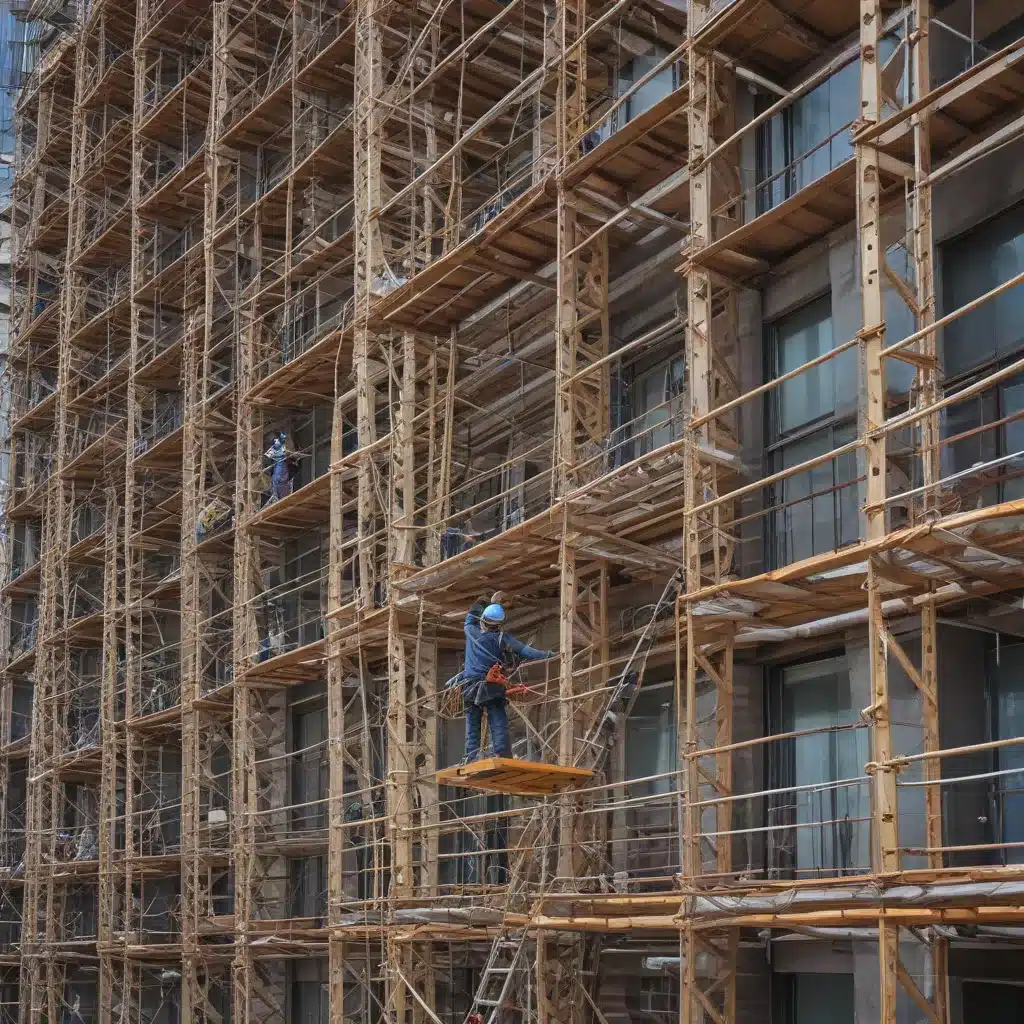
Scaffolding Safety: A Paramount Concern
As the owner of Slough Scaffolding, I’ve seen firsthand the importance of prioritizing worker safety on construction sites. Scaffolding, while an essential tool for elevated work, can also pose significant risks if not properly installed and maintained. In this comprehensive article, I’ll delve into the various hazards associated with scaffolding and share practical strategies to protect workers and ensure a safe work environment.
The Dangers of Improper Scaffolding Setup
Imagine a scenario where a scaffolding structure collapses, sending workers tumbling to the ground. This nightmare scenario is all too real, and the consequences can be devastating. Improper setup, including unstable foundations, missing guardrails, or inadequate bracing, can lead to catastrophic accidents. I’ve witnessed the aftermath of such incidents, and it’s a sobering reminder of the importance of thorough planning and execution.
One of the most common scaffolding-related hazards is the risk of falls. Workers elevated on unstable or poorly constructed platforms are at risk of falling, potentially suffering severe injuries or even fatalities. Ensuring that scaffolding is erected according to industry standards and local regulations is crucial to mitigate this threat.
Another hazard that often goes overlooked is the risk of falling objects. Loose materials, tools, or debris can easily tumble from the scaffolding, putting workers below at risk of serious harm. Implementing effective measures, such as toeboard installation and debris netting, can help prevent these dangerous incidents.
Prioritizing Worker Training and Supervision
Scaffolding safety isn’t just about the physical structure; it’s also about the human element. Proper training and supervision are essential to ensure that workers understand the risks and follow safety protocols.
I’ve seen too many instances where untrained workers, eager to get the job done, take shortcuts or disregard critical safety measures. This can lead to disastrous consequences, and it’s our responsibility as employers to provide comprehensive training and ongoing supervision.
One effective strategy is to designate a competent person on-site, responsible for overseeing scaffolding-related activities. This individual should have the necessary expertise to identify potential hazards, ensure proper setup and maintenance, and intervene when unsafe practices are observed.
Fostering a Culture of Safety
Ultimately, scaffolding safety is not just about ticking boxes or complying with regulations; it’s about fostering a genuine culture of safety within our organization. This means instilling a deep-rooted commitment to worker well-being that extends beyond the confines of the job site.
At Slough Scaffolding, we’ve made safety a core value, embedding it into every aspect of our operations. We encourage open communication, where workers feel empowered to raise concerns or suggest improvements. We also recognize and reward safe behaviors, reinforcing the importance of prioritizing safety above all else.
Embracing Technological Advancements
As the scaffolding industry continues to evolve, we’ve been at the forefront of embracing technological advancements that enhance worker safety. From innovative fall protection systems to advanced scaffolding design software, these tools have been instrumental in mitigating risks and creating safer work environments.
One particularly promising development is the integration of internet-of-things (IoT) sensors into scaffolding structures. These sensors can monitor critical parameters, such as load capacity, stability, and environmental conditions, providing real-time insights to our teams. This allows us to proactively identify and address potential issues before they escalate into dangerous situations.
Adapting to Changing Regulations and Best Practices
The scaffolding industry is subject to a constantly evolving landscape of regulations and best practices. As a responsible business, we stay diligently informed about these changes and ensure that our operations adapt accordingly.
Whether it’s the implementation of new safety standards, the introduction of stricter inspections, or the emergence of industry-wide initiatives, we are committed to staying ahead of the curve. By anticipating and embracing these changes, we can consistently provide our clients with the highest levels of safety and compliance.
Collaboration and Knowledge Sharing
Safety in the scaffolding industry is not just the responsibility of individual companies; it’s a collective effort that requires collaboration and knowledge sharing. At Slough Scaffolding, we actively engage with industry associations, regulatory bodies, and our peers to stay informed and contribute to the ongoing dialogue around scaffolding safety.
By sharing best practices, lessons learned, and innovative solutions, we can collectively raise the bar for safety standards across the industry. This collaborative approach not only benefits our own workers but also helps to protect the well-being of construction professionals throughout the region.
Conclusion: Safeguarding the Future of Scaffolding
Protecting workers from scaffolding site hazards is not just a moral imperative; it’s a fundamental responsibility that we at Slough Scaffolding take extremely seriously. By prioritizing safety, embracing technological advancements, adapting to changing regulations, and fostering a culture of collaboration, we are committed to ensuring that every worker who steps onto our scaffolding platforms returns home safely at the end of the day.
As we continue to navigate the ever-evolving landscape of the scaffolding industry, I am confident that our unwavering dedication to safety will not only safeguard the well-being of our workers but also serve as a shining example for others to follow. Together, we can create a future where scaffolding site hazards are a thing of the past, and the safety of our workers is the top priority.
So, if you’re in need of scaffolding services in the Slough area, I invite you to visit our website and learn more about how we can work together to keep your construction site safe and secure.


